Case Study: Leadership Styles and Strategic Management at Apple Inc.
VerifiedAdded on 2023/01/05
|13
|3170
|32
Case Study
AI Summary
This case study examines the leadership of Apple Inc., focusing on the contributions of Steve Jobs and Tim Cook to the company's success. The analysis delves into their distinct leadership styles, including Steve Jobs' transformational and authoritative approach, and Tim Cook's more democratic and adaptive style. The study highlights how Jobs' focus on innovation and his ability to create a unique organizational culture, alongside Cook's adept management of supply chains and product enhancements, have shaped Apple's strategic direction. The case study explores the impact of these leadership styles on strategic change, innovation, and the company's overall market performance, providing a comprehensive overview of Apple's journey to becoming a global leader in technology.
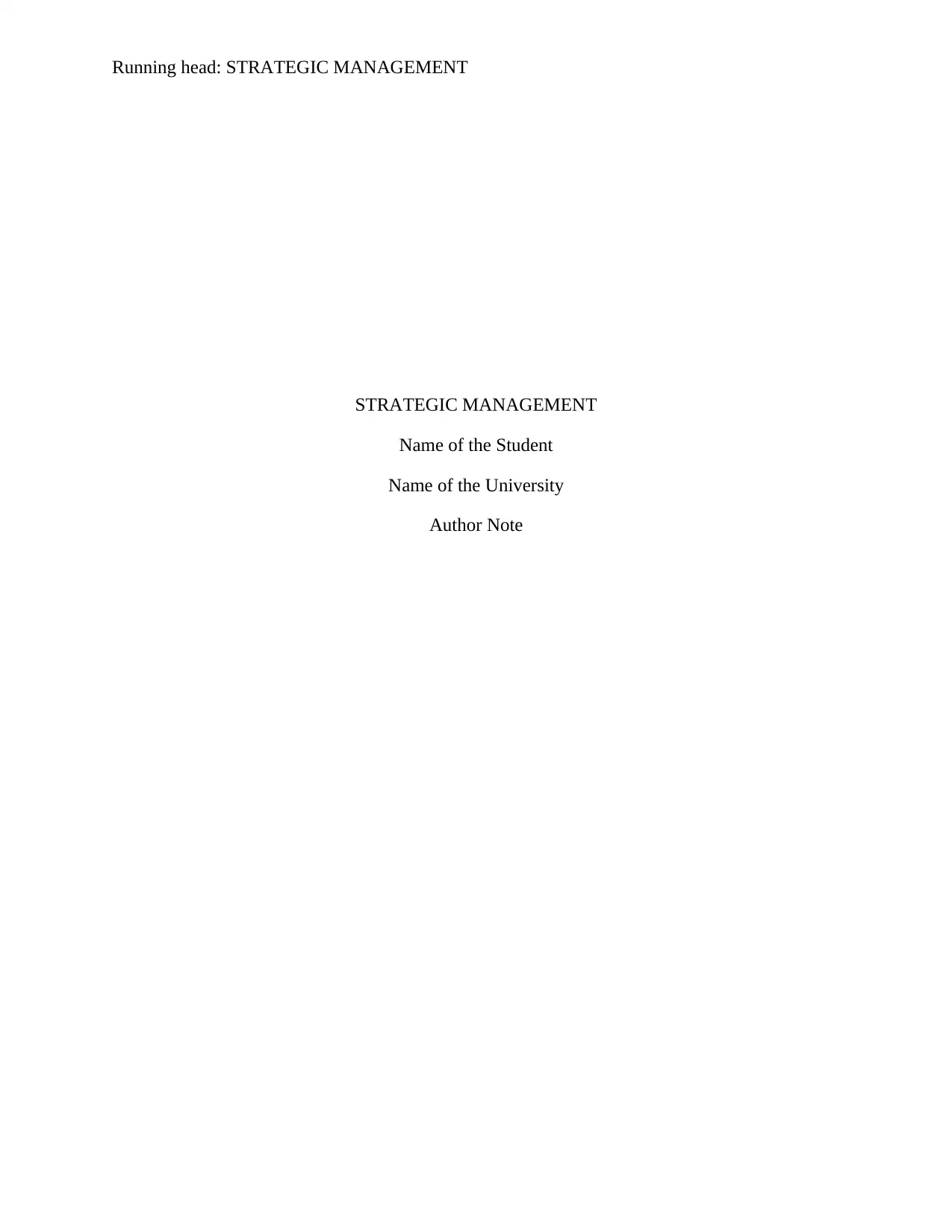
Running head: STRATEGIC MANAGEMENT
STRATEGIC MANAGEMENT
Name of the Student
Name of the University
Author Note
STRATEGIC MANAGEMENT
Name of the Student
Name of the University
Author Note
Paraphrase This Document
Need a fresh take? Get an instant paraphrase of this document with our AI Paraphraser
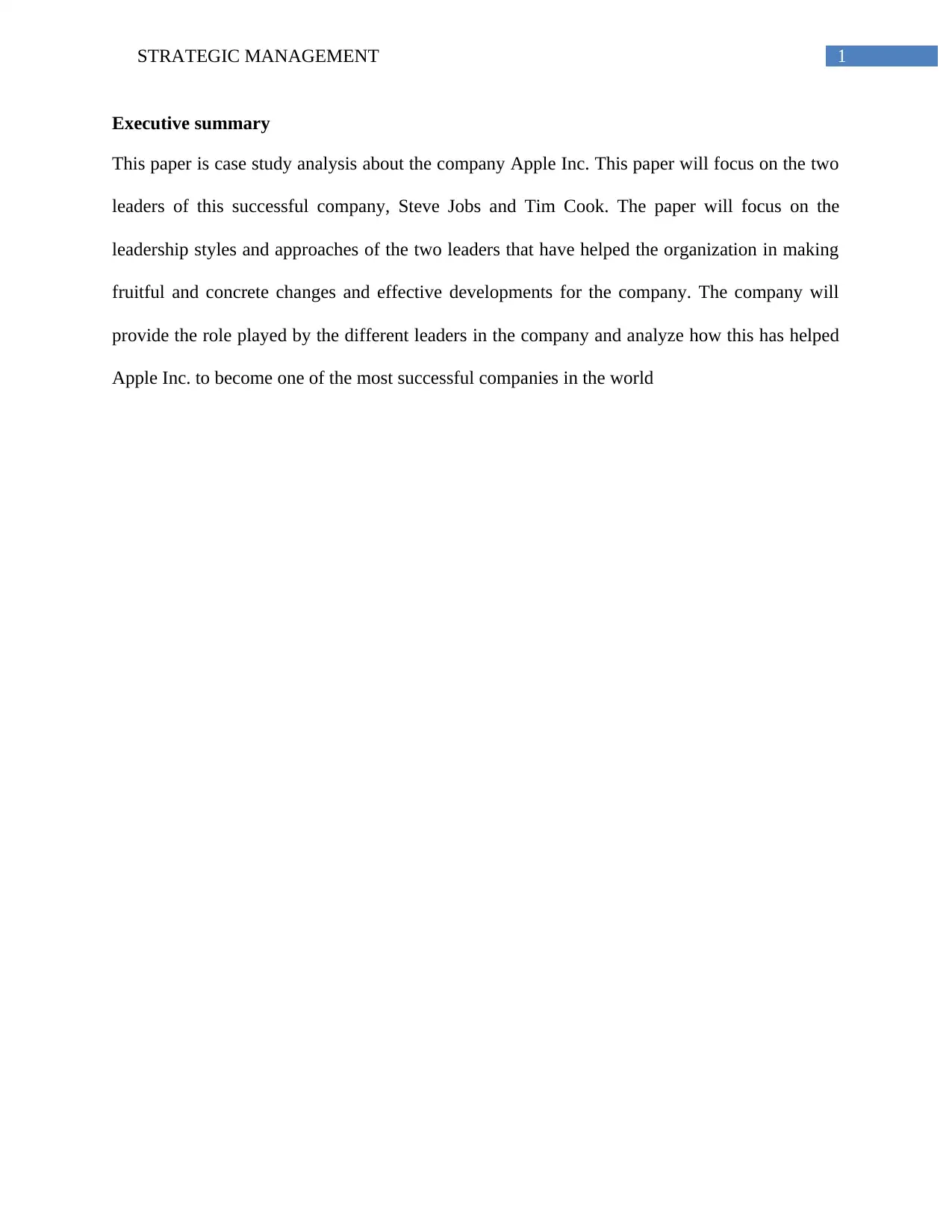
1STRATEGIC MANAGEMENT
Executive summary
This paper is case study analysis about the company Apple Inc. This paper will focus on the two
leaders of this successful company, Steve Jobs and Tim Cook. The paper will focus on the
leadership styles and approaches of the two leaders that have helped the organization in making
fruitful and concrete changes and effective developments for the company. The company will
provide the role played by the different leaders in the company and analyze how this has helped
Apple Inc. to become one of the most successful companies in the world
Executive summary
This paper is case study analysis about the company Apple Inc. This paper will focus on the two
leaders of this successful company, Steve Jobs and Tim Cook. The paper will focus on the
leadership styles and approaches of the two leaders that have helped the organization in making
fruitful and concrete changes and effective developments for the company. The company will
provide the role played by the different leaders in the company and analyze how this has helped
Apple Inc. to become one of the most successful companies in the world
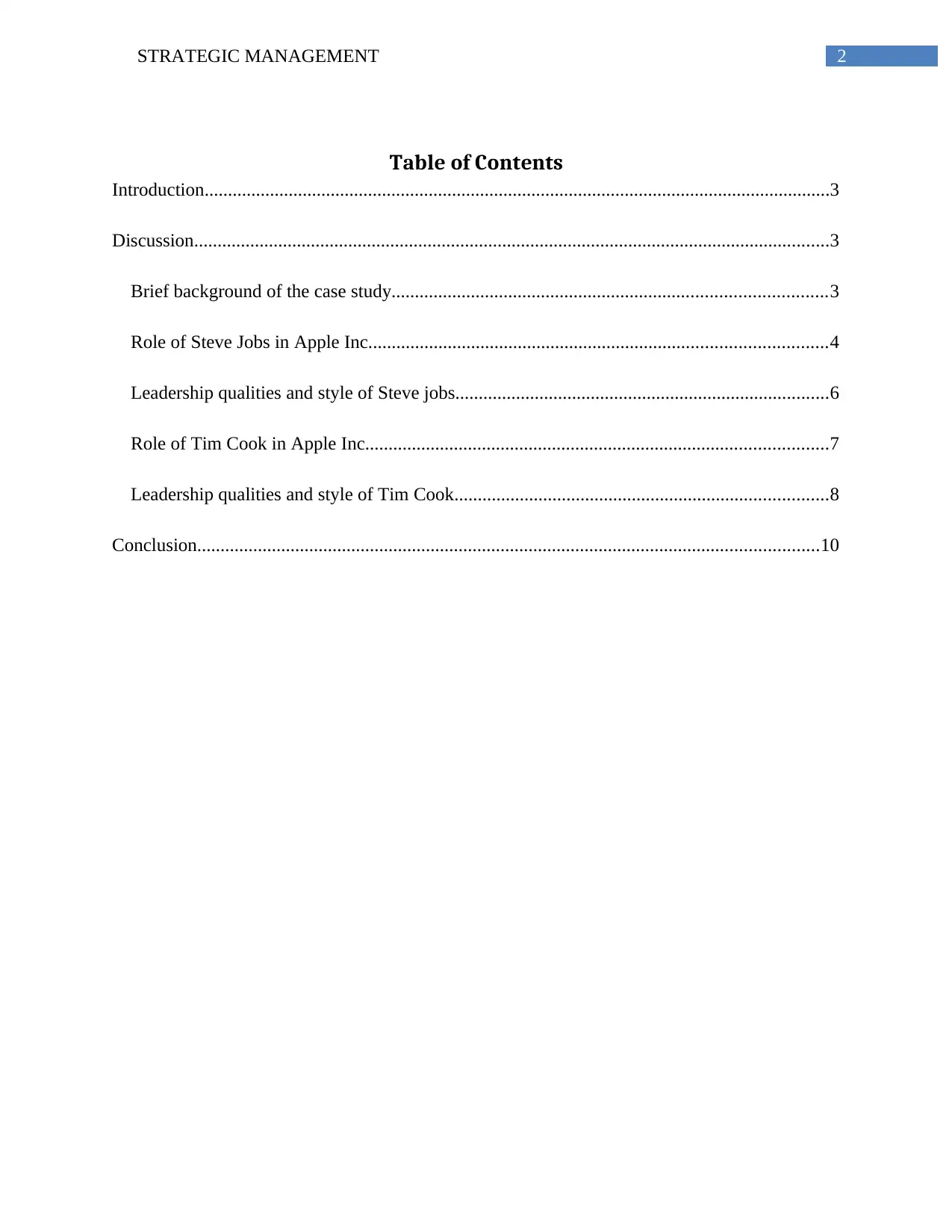
2STRATEGIC MANAGEMENT
Table of Contents
Introduction......................................................................................................................................3
Discussion........................................................................................................................................3
Brief background of the case study.............................................................................................3
Role of Steve Jobs in Apple Inc..................................................................................................4
Leadership qualities and style of Steve jobs................................................................................6
Role of Tim Cook in Apple Inc...................................................................................................7
Leadership qualities and style of Tim Cook................................................................................8
Conclusion.....................................................................................................................................10
Table of Contents
Introduction......................................................................................................................................3
Discussion........................................................................................................................................3
Brief background of the case study.............................................................................................3
Role of Steve Jobs in Apple Inc..................................................................................................4
Leadership qualities and style of Steve jobs................................................................................6
Role of Tim Cook in Apple Inc...................................................................................................7
Leadership qualities and style of Tim Cook................................................................................8
Conclusion.....................................................................................................................................10
⊘ This is a preview!⊘
Do you want full access?
Subscribe today to unlock all pages.

Trusted by 1+ million students worldwide
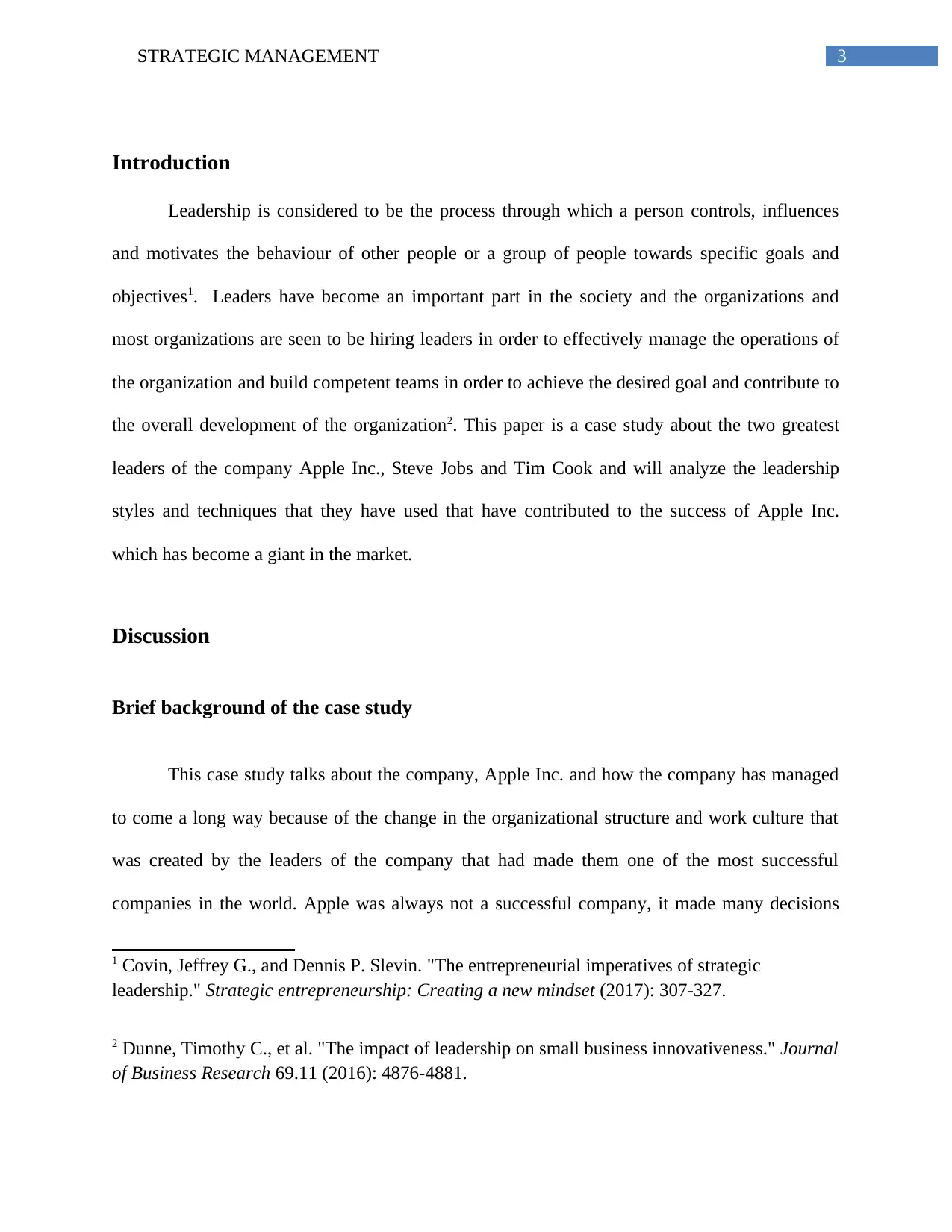
3STRATEGIC MANAGEMENT
Introduction
Leadership is considered to be the process through which a person controls, influences
and motivates the behaviour of other people or a group of people towards specific goals and
objectives1. Leaders have become an important part in the society and the organizations and
most organizations are seen to be hiring leaders in order to effectively manage the operations of
the organization and build competent teams in order to achieve the desired goal and contribute to
the overall development of the organization2. This paper is a case study about the two greatest
leaders of the company Apple Inc., Steve Jobs and Tim Cook and will analyze the leadership
styles and techniques that they have used that have contributed to the success of Apple Inc.
which has become a giant in the market.
Discussion
Brief background of the case study
This case study talks about the company, Apple Inc. and how the company has managed
to come a long way because of the change in the organizational structure and work culture that
was created by the leaders of the company that had made them one of the most successful
companies in the world. Apple was always not a successful company, it made many decisions
1 Covin, Jeffrey G., and Dennis P. Slevin. "The entrepreneurial imperatives of strategic
leadership." Strategic entrepreneurship: Creating a new mindset (2017): 307-327.
2 Dunne, Timothy C., et al. "The impact of leadership on small business innovativeness." Journal
of Business Research 69.11 (2016): 4876-4881.
Introduction
Leadership is considered to be the process through which a person controls, influences
and motivates the behaviour of other people or a group of people towards specific goals and
objectives1. Leaders have become an important part in the society and the organizations and
most organizations are seen to be hiring leaders in order to effectively manage the operations of
the organization and build competent teams in order to achieve the desired goal and contribute to
the overall development of the organization2. This paper is a case study about the two greatest
leaders of the company Apple Inc., Steve Jobs and Tim Cook and will analyze the leadership
styles and techniques that they have used that have contributed to the success of Apple Inc.
which has become a giant in the market.
Discussion
Brief background of the case study
This case study talks about the company, Apple Inc. and how the company has managed
to come a long way because of the change in the organizational structure and work culture that
was created by the leaders of the company that had made them one of the most successful
companies in the world. Apple was always not a successful company, it made many decisions
1 Covin, Jeffrey G., and Dennis P. Slevin. "The entrepreneurial imperatives of strategic
leadership." Strategic entrepreneurship: Creating a new mindset (2017): 307-327.
2 Dunne, Timothy C., et al. "The impact of leadership on small business innovativeness." Journal
of Business Research 69.11 (2016): 4876-4881.
Paraphrase This Document
Need a fresh take? Get an instant paraphrase of this document with our AI Paraphraser
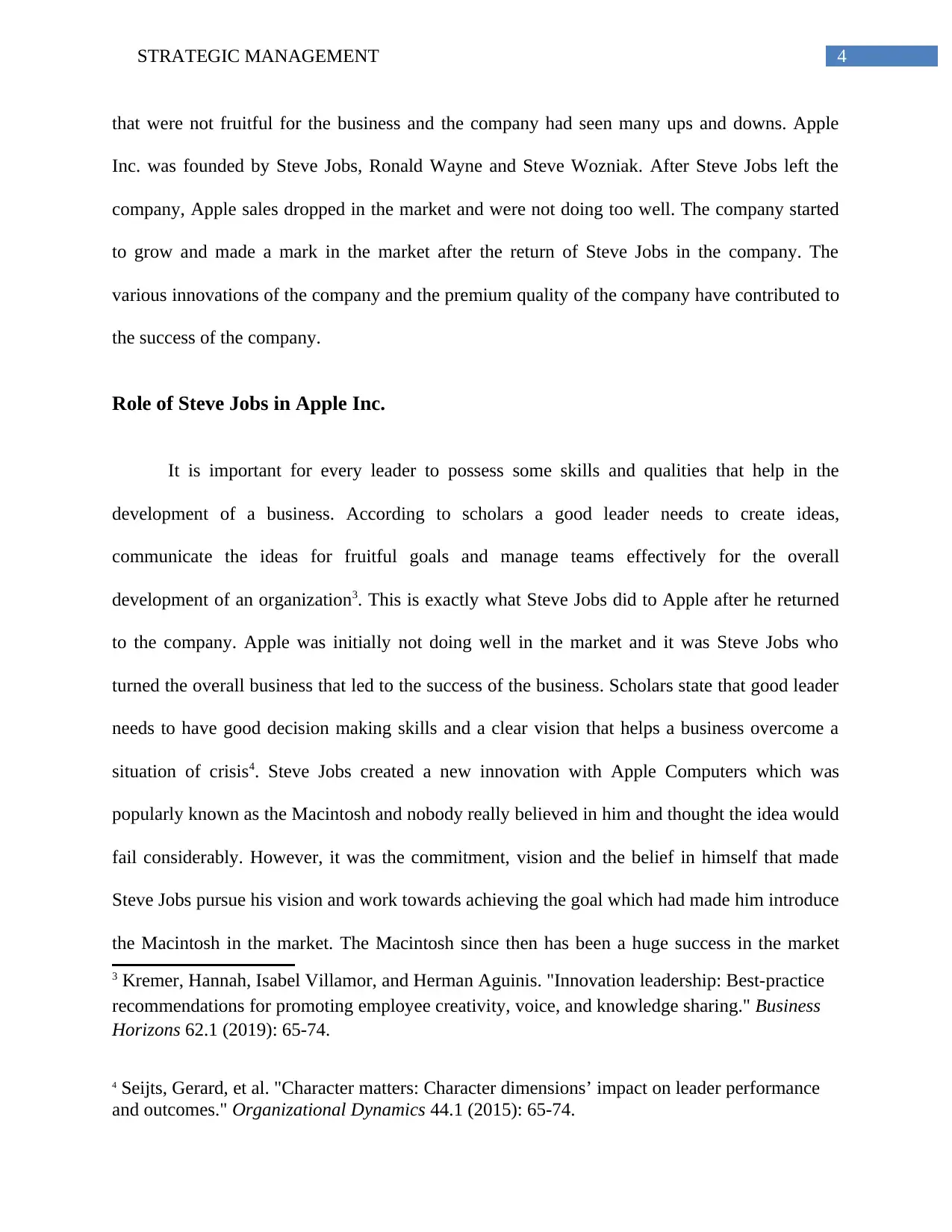
4STRATEGIC MANAGEMENT
that were not fruitful for the business and the company had seen many ups and downs. Apple
Inc. was founded by Steve Jobs, Ronald Wayne and Steve Wozniak. After Steve Jobs left the
company, Apple sales dropped in the market and were not doing too well. The company started
to grow and made a mark in the market after the return of Steve Jobs in the company. The
various innovations of the company and the premium quality of the company have contributed to
the success of the company.
Role of Steve Jobs in Apple Inc.
It is important for every leader to possess some skills and qualities that help in the
development of a business. According to scholars a good leader needs to create ideas,
communicate the ideas for fruitful goals and manage teams effectively for the overall
development of an organization3. This is exactly what Steve Jobs did to Apple after he returned
to the company. Apple was initially not doing well in the market and it was Steve Jobs who
turned the overall business that led to the success of the business. Scholars state that good leader
needs to have good decision making skills and a clear vision that helps a business overcome a
situation of crisis4. Steve Jobs created a new innovation with Apple Computers which was
popularly known as the Macintosh and nobody really believed in him and thought the idea would
fail considerably. However, it was the commitment, vision and the belief in himself that made
Steve Jobs pursue his vision and work towards achieving the goal which had made him introduce
the Macintosh in the market. The Macintosh since then has been a huge success in the market
3 Kremer, Hannah, Isabel Villamor, and Herman Aguinis. "Innovation leadership: Best-practice
recommendations for promoting employee creativity, voice, and knowledge sharing." Business
Horizons 62.1 (2019): 65-74.
4 Seijts, Gerard, et al. "Character matters: Character dimensions’ impact on leader performance
and outcomes." Organizational Dynamics 44.1 (2015): 65-74.
that were not fruitful for the business and the company had seen many ups and downs. Apple
Inc. was founded by Steve Jobs, Ronald Wayne and Steve Wozniak. After Steve Jobs left the
company, Apple sales dropped in the market and were not doing too well. The company started
to grow and made a mark in the market after the return of Steve Jobs in the company. The
various innovations of the company and the premium quality of the company have contributed to
the success of the company.
Role of Steve Jobs in Apple Inc.
It is important for every leader to possess some skills and qualities that help in the
development of a business. According to scholars a good leader needs to create ideas,
communicate the ideas for fruitful goals and manage teams effectively for the overall
development of an organization3. This is exactly what Steve Jobs did to Apple after he returned
to the company. Apple was initially not doing well in the market and it was Steve Jobs who
turned the overall business that led to the success of the business. Scholars state that good leader
needs to have good decision making skills and a clear vision that helps a business overcome a
situation of crisis4. Steve Jobs created a new innovation with Apple Computers which was
popularly known as the Macintosh and nobody really believed in him and thought the idea would
fail considerably. However, it was the commitment, vision and the belief in himself that made
Steve Jobs pursue his vision and work towards achieving the goal which had made him introduce
the Macintosh in the market. The Macintosh since then has been a huge success in the market
3 Kremer, Hannah, Isabel Villamor, and Herman Aguinis. "Innovation leadership: Best-practice
recommendations for promoting employee creativity, voice, and knowledge sharing." Business
Horizons 62.1 (2019): 65-74.
4 Seijts, Gerard, et al. "Character matters: Character dimensions’ impact on leader performance
and outcomes." Organizational Dynamics 44.1 (2015): 65-74.
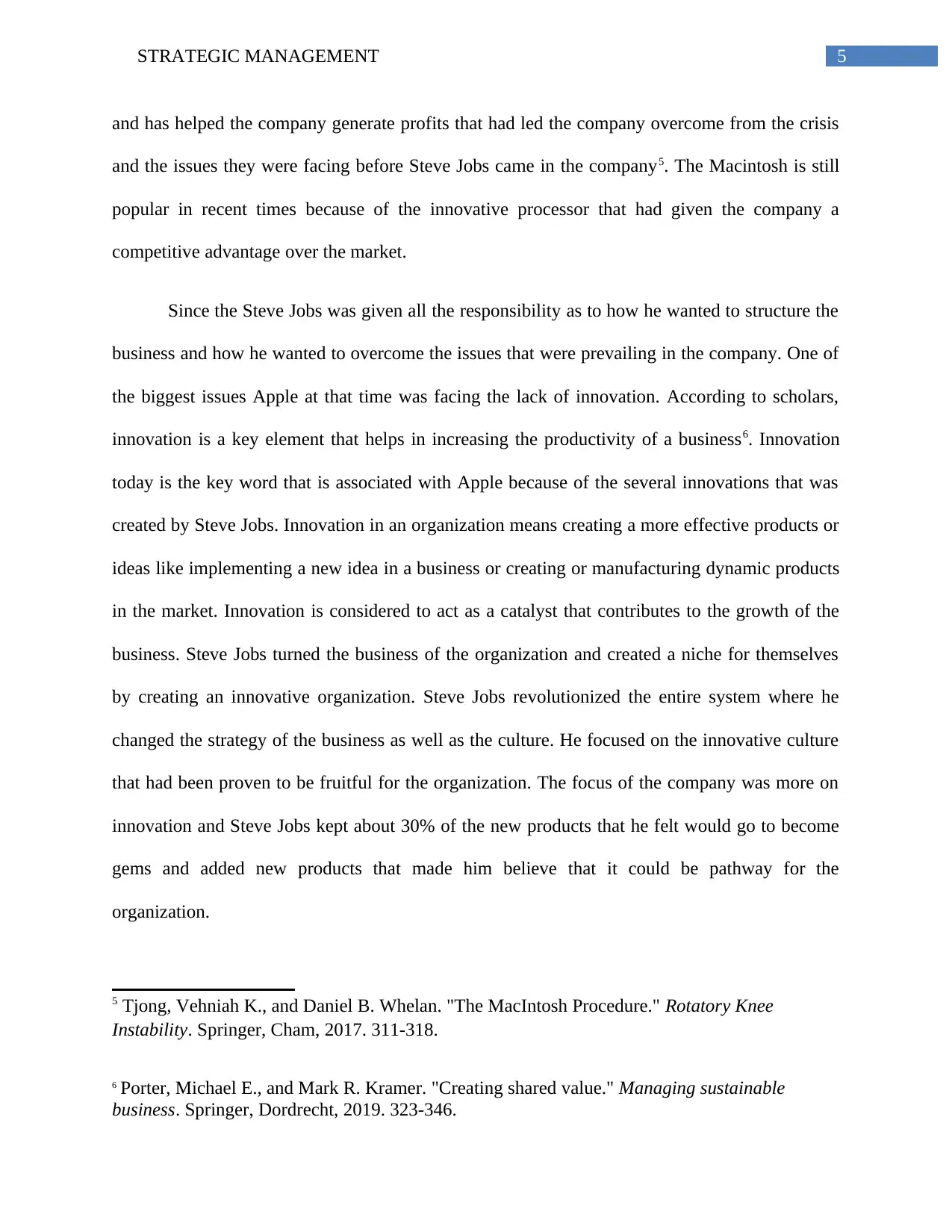
5STRATEGIC MANAGEMENT
and has helped the company generate profits that had led the company overcome from the crisis
and the issues they were facing before Steve Jobs came in the company5. The Macintosh is still
popular in recent times because of the innovative processor that had given the company a
competitive advantage over the market.
Since the Steve Jobs was given all the responsibility as to how he wanted to structure the
business and how he wanted to overcome the issues that were prevailing in the company. One of
the biggest issues Apple at that time was facing the lack of innovation. According to scholars,
innovation is a key element that helps in increasing the productivity of a business6. Innovation
today is the key word that is associated with Apple because of the several innovations that was
created by Steve Jobs. Innovation in an organization means creating a more effective products or
ideas like implementing a new idea in a business or creating or manufacturing dynamic products
in the market. Innovation is considered to act as a catalyst that contributes to the growth of the
business. Steve Jobs turned the business of the organization and created a niche for themselves
by creating an innovative organization. Steve Jobs revolutionized the entire system where he
changed the strategy of the business as well as the culture. He focused on the innovative culture
that had been proven to be fruitful for the organization. The focus of the company was more on
innovation and Steve Jobs kept about 30% of the new products that he felt would go to become
gems and added new products that made him believe that it could be pathway for the
organization.
5 Tjong, Vehniah K., and Daniel B. Whelan. "The MacIntosh Procedure." Rotatory Knee
Instability. Springer, Cham, 2017. 311-318.
6 Porter, Michael E., and Mark R. Kramer. "Creating shared value." Managing sustainable
business. Springer, Dordrecht, 2019. 323-346.
and has helped the company generate profits that had led the company overcome from the crisis
and the issues they were facing before Steve Jobs came in the company5. The Macintosh is still
popular in recent times because of the innovative processor that had given the company a
competitive advantage over the market.
Since the Steve Jobs was given all the responsibility as to how he wanted to structure the
business and how he wanted to overcome the issues that were prevailing in the company. One of
the biggest issues Apple at that time was facing the lack of innovation. According to scholars,
innovation is a key element that helps in increasing the productivity of a business6. Innovation
today is the key word that is associated with Apple because of the several innovations that was
created by Steve Jobs. Innovation in an organization means creating a more effective products or
ideas like implementing a new idea in a business or creating or manufacturing dynamic products
in the market. Innovation is considered to act as a catalyst that contributes to the growth of the
business. Steve Jobs turned the business of the organization and created a niche for themselves
by creating an innovative organization. Steve Jobs revolutionized the entire system where he
changed the strategy of the business as well as the culture. He focused on the innovative culture
that had been proven to be fruitful for the organization. The focus of the company was more on
innovation and Steve Jobs kept about 30% of the new products that he felt would go to become
gems and added new products that made him believe that it could be pathway for the
organization.
5 Tjong, Vehniah K., and Daniel B. Whelan. "The MacIntosh Procedure." Rotatory Knee
Instability. Springer, Cham, 2017. 311-318.
6 Porter, Michael E., and Mark R. Kramer. "Creating shared value." Managing sustainable
business. Springer, Dordrecht, 2019. 323-346.
⊘ This is a preview!⊘
Do you want full access?
Subscribe today to unlock all pages.

Trusted by 1+ million students worldwide
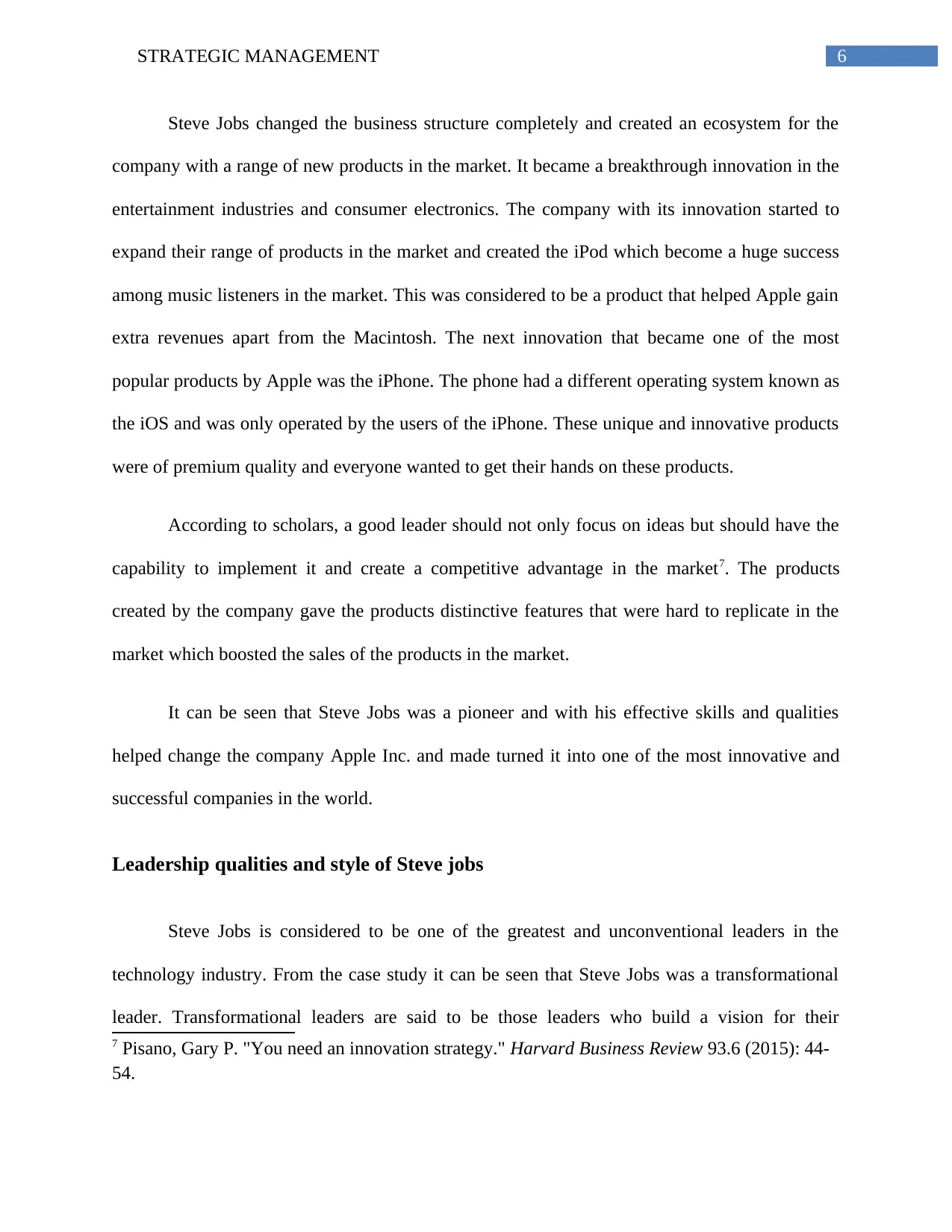
6STRATEGIC MANAGEMENT
Steve Jobs changed the business structure completely and created an ecosystem for the
company with a range of new products in the market. It became a breakthrough innovation in the
entertainment industries and consumer electronics. The company with its innovation started to
expand their range of products in the market and created the iPod which become a huge success
among music listeners in the market. This was considered to be a product that helped Apple gain
extra revenues apart from the Macintosh. The next innovation that became one of the most
popular products by Apple was the iPhone. The phone had a different operating system known as
the iOS and was only operated by the users of the iPhone. These unique and innovative products
were of premium quality and everyone wanted to get their hands on these products.
According to scholars, a good leader should not only focus on ideas but should have the
capability to implement it and create a competitive advantage in the market7. The products
created by the company gave the products distinctive features that were hard to replicate in the
market which boosted the sales of the products in the market.
It can be seen that Steve Jobs was a pioneer and with his effective skills and qualities
helped change the company Apple Inc. and made turned it into one of the most innovative and
successful companies in the world.
Leadership qualities and style of Steve jobs
Steve Jobs is considered to be one of the greatest and unconventional leaders in the
technology industry. From the case study it can be seen that Steve Jobs was a transformational
leader. Transformational leaders are said to be those leaders who build a vision for their
7 Pisano, Gary P. "You need an innovation strategy." Harvard Business Review 93.6 (2015): 44-
54.
Steve Jobs changed the business structure completely and created an ecosystem for the
company with a range of new products in the market. It became a breakthrough innovation in the
entertainment industries and consumer electronics. The company with its innovation started to
expand their range of products in the market and created the iPod which become a huge success
among music listeners in the market. This was considered to be a product that helped Apple gain
extra revenues apart from the Macintosh. The next innovation that became one of the most
popular products by Apple was the iPhone. The phone had a different operating system known as
the iOS and was only operated by the users of the iPhone. These unique and innovative products
were of premium quality and everyone wanted to get their hands on these products.
According to scholars, a good leader should not only focus on ideas but should have the
capability to implement it and create a competitive advantage in the market7. The products
created by the company gave the products distinctive features that were hard to replicate in the
market which boosted the sales of the products in the market.
It can be seen that Steve Jobs was a pioneer and with his effective skills and qualities
helped change the company Apple Inc. and made turned it into one of the most innovative and
successful companies in the world.
Leadership qualities and style of Steve jobs
Steve Jobs is considered to be one of the greatest and unconventional leaders in the
technology industry. From the case study it can be seen that Steve Jobs was a transformational
leader. Transformational leaders are said to be those leaders who build a vision for their
7 Pisano, Gary P. "You need an innovation strategy." Harvard Business Review 93.6 (2015): 44-
54.
Paraphrase This Document
Need a fresh take? Get an instant paraphrase of this document with our AI Paraphraser
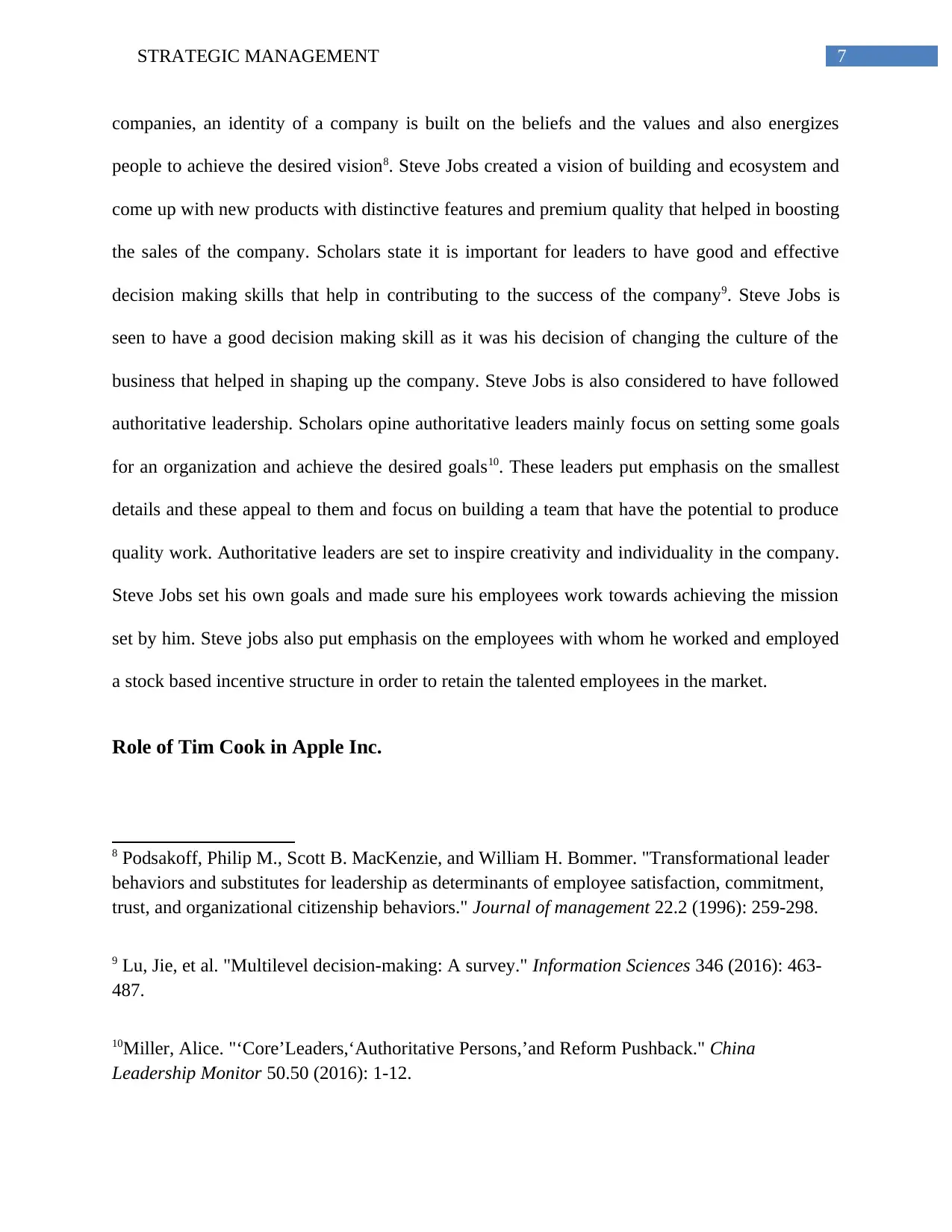
7STRATEGIC MANAGEMENT
companies, an identity of a company is built on the beliefs and the values and also energizes
people to achieve the desired vision8. Steve Jobs created a vision of building and ecosystem and
come up with new products with distinctive features and premium quality that helped in boosting
the sales of the company. Scholars state it is important for leaders to have good and effective
decision making skills that help in contributing to the success of the company9. Steve Jobs is
seen to have a good decision making skill as it was his decision of changing the culture of the
business that helped in shaping up the company. Steve Jobs is also considered to have followed
authoritative leadership. Scholars opine authoritative leaders mainly focus on setting some goals
for an organization and achieve the desired goals10. These leaders put emphasis on the smallest
details and these appeal to them and focus on building a team that have the potential to produce
quality work. Authoritative leaders are set to inspire creativity and individuality in the company.
Steve Jobs set his own goals and made sure his employees work towards achieving the mission
set by him. Steve jobs also put emphasis on the employees with whom he worked and employed
a stock based incentive structure in order to retain the talented employees in the market.
Role of Tim Cook in Apple Inc.
8 Podsakoff, Philip M., Scott B. MacKenzie, and William H. Bommer. "Transformational leader
behaviors and substitutes for leadership as determinants of employee satisfaction, commitment,
trust, and organizational citizenship behaviors." Journal of management 22.2 (1996): 259-298.
9 Lu, Jie, et al. "Multilevel decision-making: A survey." Information Sciences 346 (2016): 463-
487.
10Miller, Alice. "‘Core’Leaders,‘Authoritative Persons,’and Reform Pushback." China
Leadership Monitor 50.50 (2016): 1-12.
companies, an identity of a company is built on the beliefs and the values and also energizes
people to achieve the desired vision8. Steve Jobs created a vision of building and ecosystem and
come up with new products with distinctive features and premium quality that helped in boosting
the sales of the company. Scholars state it is important for leaders to have good and effective
decision making skills that help in contributing to the success of the company9. Steve Jobs is
seen to have a good decision making skill as it was his decision of changing the culture of the
business that helped in shaping up the company. Steve Jobs is also considered to have followed
authoritative leadership. Scholars opine authoritative leaders mainly focus on setting some goals
for an organization and achieve the desired goals10. These leaders put emphasis on the smallest
details and these appeal to them and focus on building a team that have the potential to produce
quality work. Authoritative leaders are set to inspire creativity and individuality in the company.
Steve Jobs set his own goals and made sure his employees work towards achieving the mission
set by him. Steve jobs also put emphasis on the employees with whom he worked and employed
a stock based incentive structure in order to retain the talented employees in the market.
Role of Tim Cook in Apple Inc.
8 Podsakoff, Philip M., Scott B. MacKenzie, and William H. Bommer. "Transformational leader
behaviors and substitutes for leadership as determinants of employee satisfaction, commitment,
trust, and organizational citizenship behaviors." Journal of management 22.2 (1996): 259-298.
9 Lu, Jie, et al. "Multilevel decision-making: A survey." Information Sciences 346 (2016): 463-
487.
10Miller, Alice. "‘Core’Leaders,‘Authoritative Persons,’and Reform Pushback." China
Leadership Monitor 50.50 (2016): 1-12.
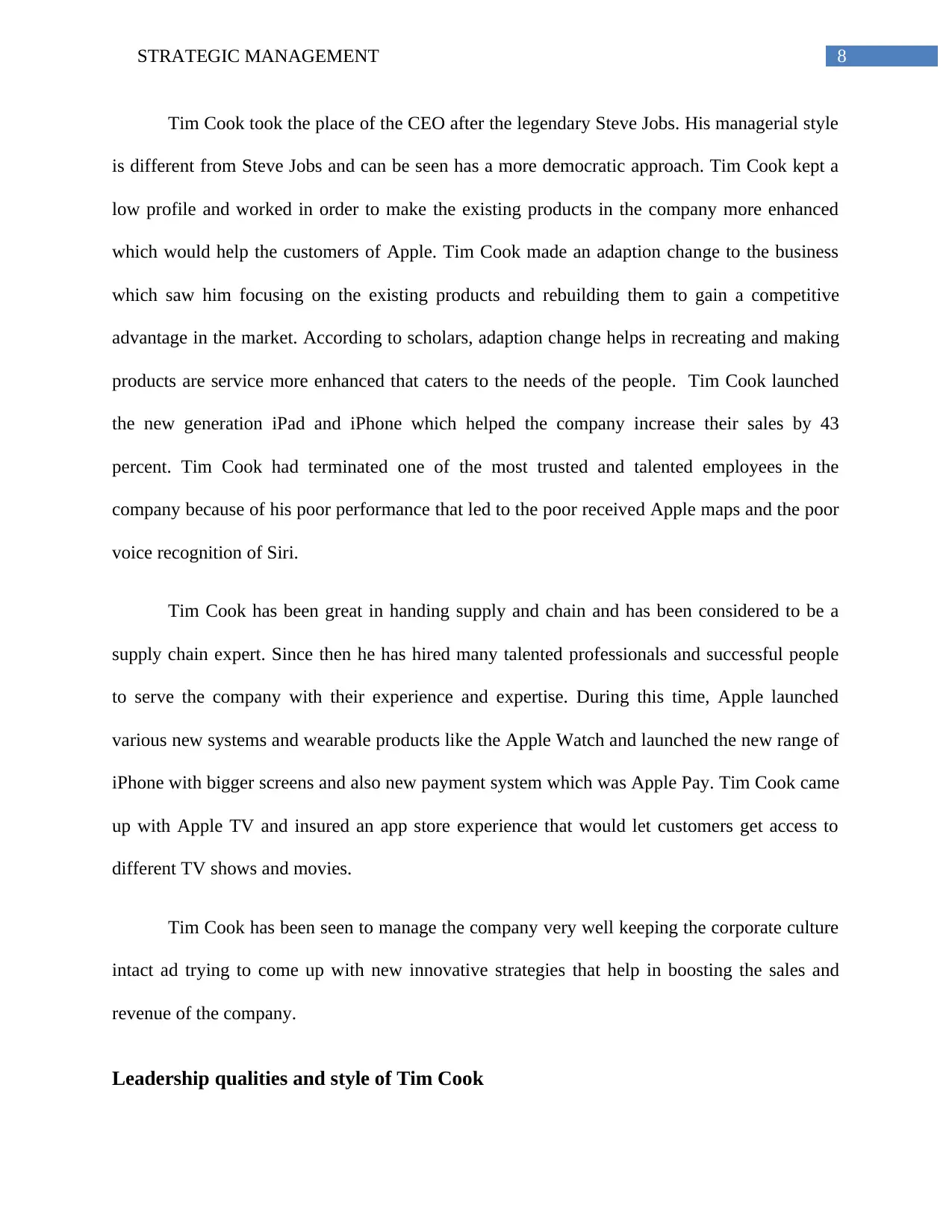
8STRATEGIC MANAGEMENT
Tim Cook took the place of the CEO after the legendary Steve Jobs. His managerial style
is different from Steve Jobs and can be seen has a more democratic approach. Tim Cook kept a
low profile and worked in order to make the existing products in the company more enhanced
which would help the customers of Apple. Tim Cook made an adaption change to the business
which saw him focusing on the existing products and rebuilding them to gain a competitive
advantage in the market. According to scholars, adaption change helps in recreating and making
products are service more enhanced that caters to the needs of the people. Tim Cook launched
the new generation iPad and iPhone which helped the company increase their sales by 43
percent. Tim Cook had terminated one of the most trusted and talented employees in the
company because of his poor performance that led to the poor received Apple maps and the poor
voice recognition of Siri.
Tim Cook has been great in handing supply and chain and has been considered to be a
supply chain expert. Since then he has hired many talented professionals and successful people
to serve the company with their experience and expertise. During this time, Apple launched
various new systems and wearable products like the Apple Watch and launched the new range of
iPhone with bigger screens and also new payment system which was Apple Pay. Tim Cook came
up with Apple TV and insured an app store experience that would let customers get access to
different TV shows and movies.
Tim Cook has been seen to manage the company very well keeping the corporate culture
intact ad trying to come up with new innovative strategies that help in boosting the sales and
revenue of the company.
Leadership qualities and style of Tim Cook
Tim Cook took the place of the CEO after the legendary Steve Jobs. His managerial style
is different from Steve Jobs and can be seen has a more democratic approach. Tim Cook kept a
low profile and worked in order to make the existing products in the company more enhanced
which would help the customers of Apple. Tim Cook made an adaption change to the business
which saw him focusing on the existing products and rebuilding them to gain a competitive
advantage in the market. According to scholars, adaption change helps in recreating and making
products are service more enhanced that caters to the needs of the people. Tim Cook launched
the new generation iPad and iPhone which helped the company increase their sales by 43
percent. Tim Cook had terminated one of the most trusted and talented employees in the
company because of his poor performance that led to the poor received Apple maps and the poor
voice recognition of Siri.
Tim Cook has been great in handing supply and chain and has been considered to be a
supply chain expert. Since then he has hired many talented professionals and successful people
to serve the company with their experience and expertise. During this time, Apple launched
various new systems and wearable products like the Apple Watch and launched the new range of
iPhone with bigger screens and also new payment system which was Apple Pay. Tim Cook came
up with Apple TV and insured an app store experience that would let customers get access to
different TV shows and movies.
Tim Cook has been seen to manage the company very well keeping the corporate culture
intact ad trying to come up with new innovative strategies that help in boosting the sales and
revenue of the company.
Leadership qualities and style of Tim Cook
⊘ This is a preview!⊘
Do you want full access?
Subscribe today to unlock all pages.

Trusted by 1+ million students worldwide
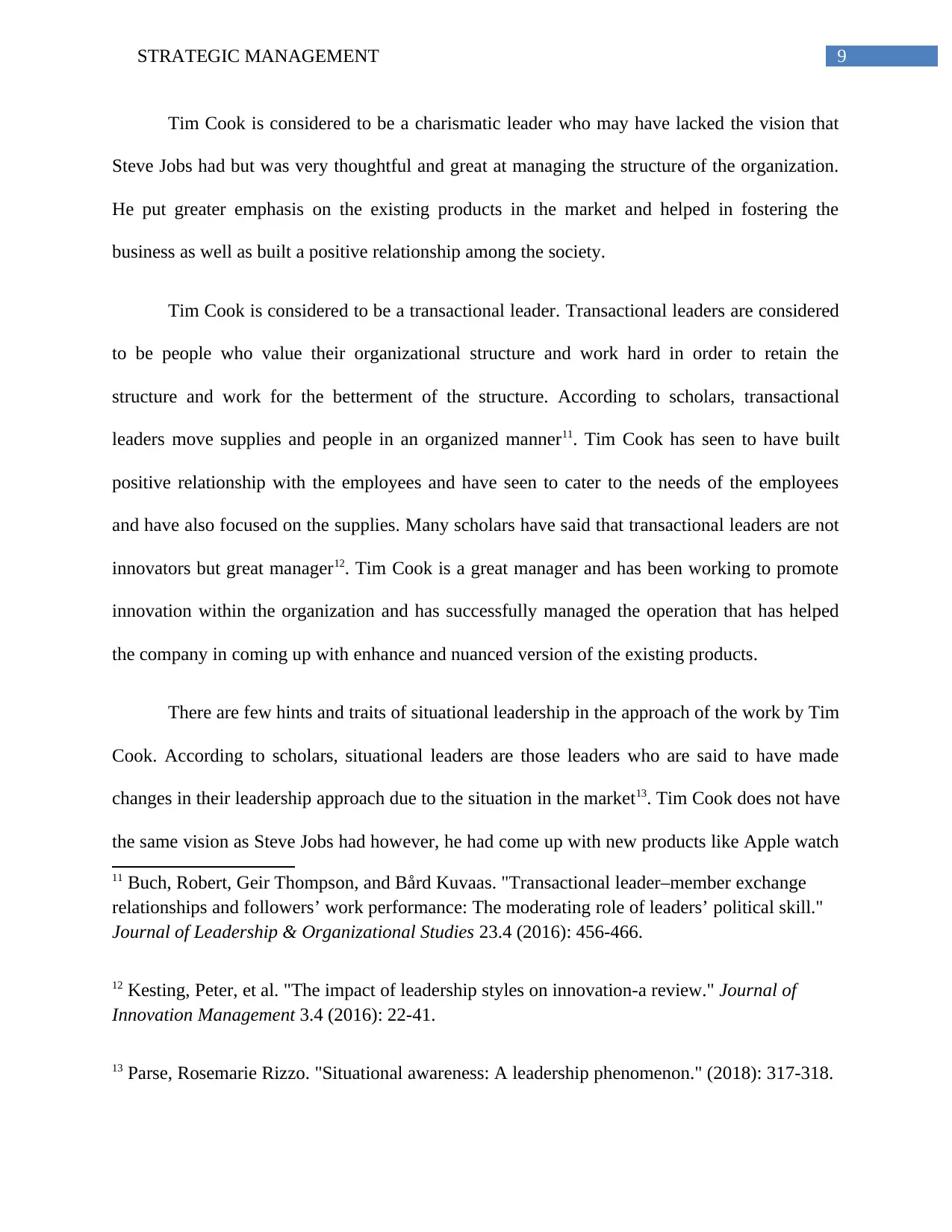
9STRATEGIC MANAGEMENT
Tim Cook is considered to be a charismatic leader who may have lacked the vision that
Steve Jobs had but was very thoughtful and great at managing the structure of the organization.
He put greater emphasis on the existing products in the market and helped in fostering the
business as well as built a positive relationship among the society.
Tim Cook is considered to be a transactional leader. Transactional leaders are considered
to be people who value their organizational structure and work hard in order to retain the
structure and work for the betterment of the structure. According to scholars, transactional
leaders move supplies and people in an organized manner11. Tim Cook has seen to have built
positive relationship with the employees and have seen to cater to the needs of the employees
and have also focused on the supplies. Many scholars have said that transactional leaders are not
innovators but great manager12. Tim Cook is a great manager and has been working to promote
innovation within the organization and has successfully managed the operation that has helped
the company in coming up with enhance and nuanced version of the existing products.
There are few hints and traits of situational leadership in the approach of the work by Tim
Cook. According to scholars, situational leaders are those leaders who are said to have made
changes in their leadership approach due to the situation in the market13. Tim Cook does not have
the same vision as Steve Jobs had however, he had come up with new products like Apple watch
11 Buch, Robert, Geir Thompson, and Bård Kuvaas. "Transactional leader–member exchange
relationships and followers’ work performance: The moderating role of leaders’ political skill."
Journal of Leadership & Organizational Studies 23.4 (2016): 456-466.
12 Kesting, Peter, et al. "The impact of leadership styles on innovation-a review." Journal of
Innovation Management 3.4 (2016): 22-41.
13 Parse, Rosemarie Rizzo. "Situational awareness: A leadership phenomenon." (2018): 317-318.
Tim Cook is considered to be a charismatic leader who may have lacked the vision that
Steve Jobs had but was very thoughtful and great at managing the structure of the organization.
He put greater emphasis on the existing products in the market and helped in fostering the
business as well as built a positive relationship among the society.
Tim Cook is considered to be a transactional leader. Transactional leaders are considered
to be people who value their organizational structure and work hard in order to retain the
structure and work for the betterment of the structure. According to scholars, transactional
leaders move supplies and people in an organized manner11. Tim Cook has seen to have built
positive relationship with the employees and have seen to cater to the needs of the employees
and have also focused on the supplies. Many scholars have said that transactional leaders are not
innovators but great manager12. Tim Cook is a great manager and has been working to promote
innovation within the organization and has successfully managed the operation that has helped
the company in coming up with enhance and nuanced version of the existing products.
There are few hints and traits of situational leadership in the approach of the work by Tim
Cook. According to scholars, situational leaders are those leaders who are said to have made
changes in their leadership approach due to the situation in the market13. Tim Cook does not have
the same vision as Steve Jobs had however, he had come up with new products like Apple watch
11 Buch, Robert, Geir Thompson, and Bård Kuvaas. "Transactional leader–member exchange
relationships and followers’ work performance: The moderating role of leaders’ political skill."
Journal of Leadership & Organizational Studies 23.4 (2016): 456-466.
12 Kesting, Peter, et al. "The impact of leadership styles on innovation-a review." Journal of
Innovation Management 3.4 (2016): 22-41.
13 Parse, Rosemarie Rizzo. "Situational awareness: A leadership phenomenon." (2018): 317-318.
Paraphrase This Document
Need a fresh take? Get an instant paraphrase of this document with our AI Paraphraser
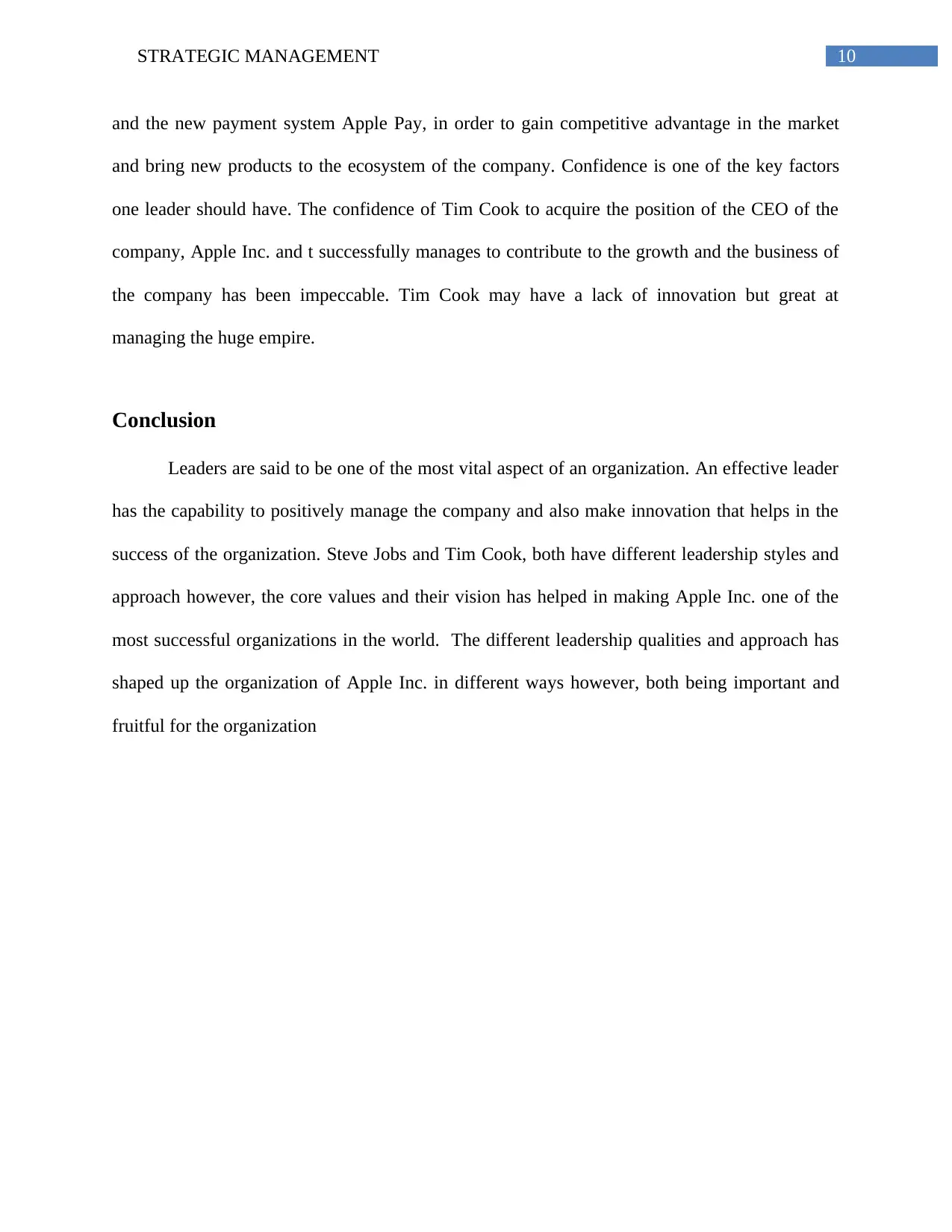
10STRATEGIC MANAGEMENT
and the new payment system Apple Pay, in order to gain competitive advantage in the market
and bring new products to the ecosystem of the company. Confidence is one of the key factors
one leader should have. The confidence of Tim Cook to acquire the position of the CEO of the
company, Apple Inc. and t successfully manages to contribute to the growth and the business of
the company has been impeccable. Tim Cook may have a lack of innovation but great at
managing the huge empire.
Conclusion
Leaders are said to be one of the most vital aspect of an organization. An effective leader
has the capability to positively manage the company and also make innovation that helps in the
success of the organization. Steve Jobs and Tim Cook, both have different leadership styles and
approach however, the core values and their vision has helped in making Apple Inc. one of the
most successful organizations in the world. The different leadership qualities and approach has
shaped up the organization of Apple Inc. in different ways however, both being important and
fruitful for the organization
and the new payment system Apple Pay, in order to gain competitive advantage in the market
and bring new products to the ecosystem of the company. Confidence is one of the key factors
one leader should have. The confidence of Tim Cook to acquire the position of the CEO of the
company, Apple Inc. and t successfully manages to contribute to the growth and the business of
the company has been impeccable. Tim Cook may have a lack of innovation but great at
managing the huge empire.
Conclusion
Leaders are said to be one of the most vital aspect of an organization. An effective leader
has the capability to positively manage the company and also make innovation that helps in the
success of the organization. Steve Jobs and Tim Cook, both have different leadership styles and
approach however, the core values and their vision has helped in making Apple Inc. one of the
most successful organizations in the world. The different leadership qualities and approach has
shaped up the organization of Apple Inc. in different ways however, both being important and
fruitful for the organization
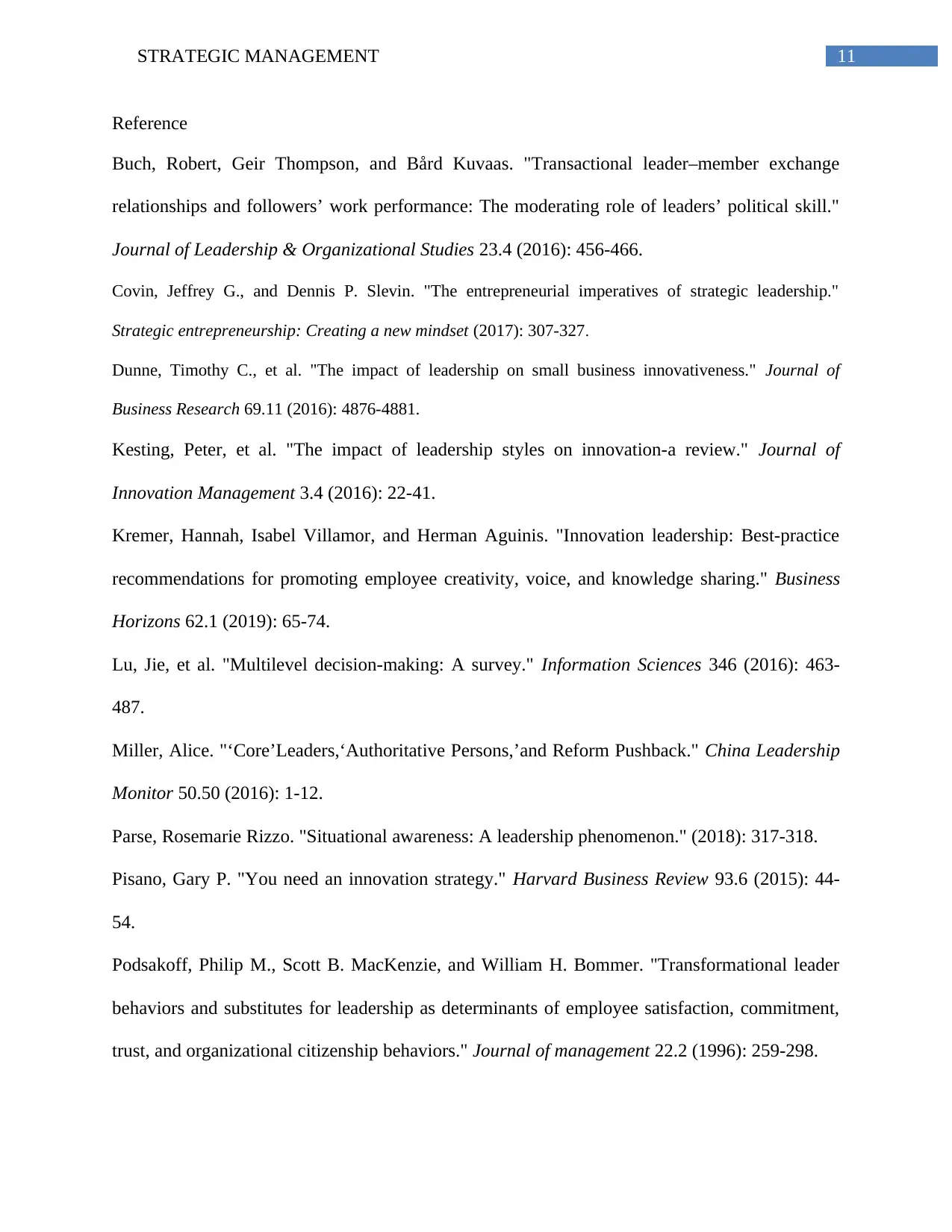
11STRATEGIC MANAGEMENT
Reference
Buch, Robert, Geir Thompson, and Bård Kuvaas. "Transactional leader–member exchange
relationships and followers’ work performance: The moderating role of leaders’ political skill."
Journal of Leadership & Organizational Studies 23.4 (2016): 456-466.
Covin, Jeffrey G., and Dennis P. Slevin. "The entrepreneurial imperatives of strategic leadership."
Strategic entrepreneurship: Creating a new mindset (2017): 307-327.
Dunne, Timothy C., et al. "The impact of leadership on small business innovativeness." Journal of
Business Research 69.11 (2016): 4876-4881.
Kesting, Peter, et al. "The impact of leadership styles on innovation-a review." Journal of
Innovation Management 3.4 (2016): 22-41.
Kremer, Hannah, Isabel Villamor, and Herman Aguinis. "Innovation leadership: Best-practice
recommendations for promoting employee creativity, voice, and knowledge sharing." Business
Horizons 62.1 (2019): 65-74.
Lu, Jie, et al. "Multilevel decision-making: A survey." Information Sciences 346 (2016): 463-
487.
Miller, Alice. "‘Core’Leaders,‘Authoritative Persons,’and Reform Pushback." China Leadership
Monitor 50.50 (2016): 1-12.
Parse, Rosemarie Rizzo. "Situational awareness: A leadership phenomenon." (2018): 317-318.
Pisano, Gary P. "You need an innovation strategy." Harvard Business Review 93.6 (2015): 44-
54.
Podsakoff, Philip M., Scott B. MacKenzie, and William H. Bommer. "Transformational leader
behaviors and substitutes for leadership as determinants of employee satisfaction, commitment,
trust, and organizational citizenship behaviors." Journal of management 22.2 (1996): 259-298.
Reference
Buch, Robert, Geir Thompson, and Bård Kuvaas. "Transactional leader–member exchange
relationships and followers’ work performance: The moderating role of leaders’ political skill."
Journal of Leadership & Organizational Studies 23.4 (2016): 456-466.
Covin, Jeffrey G., and Dennis P. Slevin. "The entrepreneurial imperatives of strategic leadership."
Strategic entrepreneurship: Creating a new mindset (2017): 307-327.
Dunne, Timothy C., et al. "The impact of leadership on small business innovativeness." Journal of
Business Research 69.11 (2016): 4876-4881.
Kesting, Peter, et al. "The impact of leadership styles on innovation-a review." Journal of
Innovation Management 3.4 (2016): 22-41.
Kremer, Hannah, Isabel Villamor, and Herman Aguinis. "Innovation leadership: Best-practice
recommendations for promoting employee creativity, voice, and knowledge sharing." Business
Horizons 62.1 (2019): 65-74.
Lu, Jie, et al. "Multilevel decision-making: A survey." Information Sciences 346 (2016): 463-
487.
Miller, Alice. "‘Core’Leaders,‘Authoritative Persons,’and Reform Pushback." China Leadership
Monitor 50.50 (2016): 1-12.
Parse, Rosemarie Rizzo. "Situational awareness: A leadership phenomenon." (2018): 317-318.
Pisano, Gary P. "You need an innovation strategy." Harvard Business Review 93.6 (2015): 44-
54.
Podsakoff, Philip M., Scott B. MacKenzie, and William H. Bommer. "Transformational leader
behaviors and substitutes for leadership as determinants of employee satisfaction, commitment,
trust, and organizational citizenship behaviors." Journal of management 22.2 (1996): 259-298.
⊘ This is a preview!⊘
Do you want full access?
Subscribe today to unlock all pages.

Trusted by 1+ million students worldwide
1 out of 13
Related Documents
Your All-in-One AI-Powered Toolkit for Academic Success.
+13062052269
info@desklib.com
Available 24*7 on WhatsApp / Email
![[object Object]](/_next/static/media/star-bottom.7253800d.svg)
Unlock your academic potential
Copyright © 2020–2025 A2Z Services. All Rights Reserved. Developed and managed by ZUCOL.





